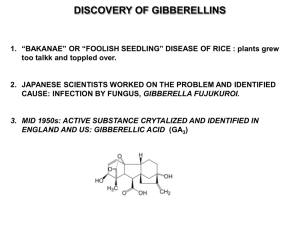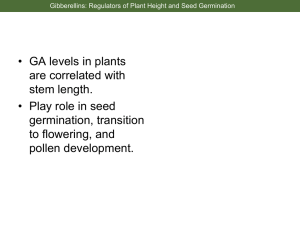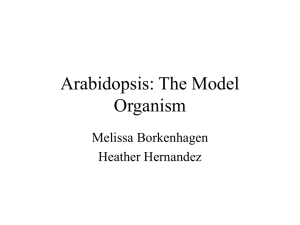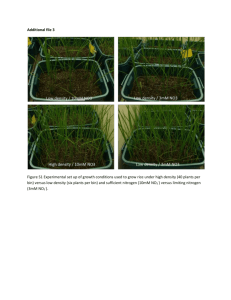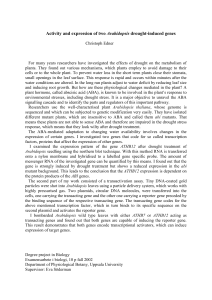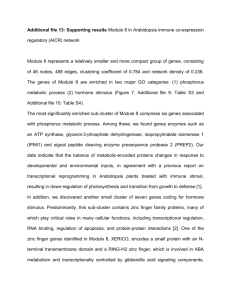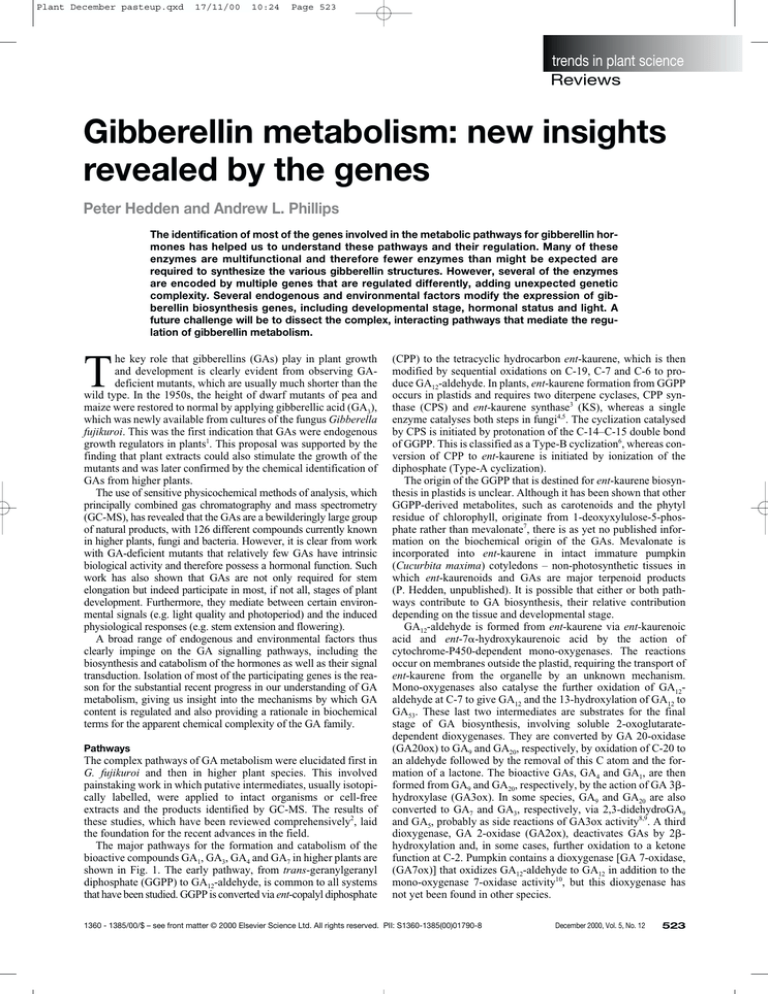
Plant December pasteup.qxd
17/11/00
10:24
Page 523
trends in plant science
Reviews
Gibberellin metabolism: new insights
revealed by the genes
Peter Hedden and Andrew L. Phillips
The identification of most of the genes involved in the metabolic pathways for gibberellin hormones has helped us to understand these pathways and their regulation. Many of these
enzymes are multifunctional and therefore fewer enzymes than might be expected are
required to synthesize the various gibberellin structures. However, several of the enzymes
are encoded by multiple genes that are regulated differently, adding unexpected genetic
complexity. Several endogenous and environmental factors modify the expression of gibberellin biosynthesis genes, including developmental stage, hormonal status and light. A
future challenge will be to dissect the complex, interacting pathways that mediate the regulation of gibberellin metabolism.
he key role that gibberellins (GAs) play in plant growth
and development is clearly evident from observing GAdeficient mutants, which are usually much shorter than the
wild type. In the 1950s, the height of dwarf mutants of pea and
maize were restored to normal by applying gibberellic acid (GA3),
which was newly available from cultures of the fungus Gibberella
fujikuroi. This was the first indication that GAs were endogenous
growth regulators in plants1. This proposal was supported by the
finding that plant extracts could also stimulate the growth of the
mutants and was later confirmed by the chemical identification of
GAs from higher plants.
The use of sensitive physicochemical methods of analysis, which
principally combined gas chromatography and mass spectrometry
(GC-MS), has revealed that the GAs are a bewilderingly large group
of natural products, with 126 different compounds currently known
in higher plants, fungi and bacteria. However, it is clear from work
with GA-deficient mutants that relatively few GAs have intrinsic
biological activity and therefore possess a hormonal function. Such
work has also shown that GAs are not only required for stem
elongation but indeed participate in most, if not all, stages of plant
development. Furthermore, they mediate between certain environmental signals (e.g. light quality and photoperiod) and the induced
physiological responses (e.g. stem extension and flowering).
A broad range of endogenous and environmental factors thus
clearly impinge on the GA signalling pathways, including the
biosynthesis and catabolism of the hormones as well as their signal
transduction. Isolation of most of the participating genes is the reason for the substantial recent progress in our understanding of GA
metabolism, giving us insight into the mechanisms by which GA
content is regulated and also providing a rationale in biochemical
terms for the apparent chemical complexity of the GA family.
T
Pathways
The complex pathways of GA metabolism were elucidated first in
G. fujikuroi and then in higher plant species. This involved
painstaking work in which putative intermediates, usually isotopically labelled, were applied to intact organisms or cell-free
extracts and the products identified by GC-MS. The results of
these studies, which have been reviewed comprehensively2, laid
the foundation for the recent advances in the field.
The major pathways for the formation and catabolism of the
bioactive compounds GA1, GA3, GA4 and GA7 in higher plants are
shown in Fig. 1. The early pathway, from trans-geranylgeranyl
diphosphate (GGPP) to GA12-aldehyde, is common to all systems
that have been studied. GGPP is converted via ent-copalyl diphosphate
(CPP) to the tetracyclic hydrocarbon ent-kaurene, which is then
modified by sequential oxidations on C-19, C-7 and C-6 to produce GA12-aldehyde. In plants, ent-kaurene formation from GGPP
occurs in plastids and requires two diterpene cyclases, CPP synthase (CPS) and ent-kaurene synthase3 (KS), whereas a single
enzyme catalyses both steps in fungi4,5. The cyclization catalysed
by CPS is initiated by protonation of the C-14–C-15 double bond
of GGPP. This is classified as a Type-B cyclization6, whereas conversion of CPP to ent-kaurene is initiated by ionization of the
diphosphate (Type-A cyclization).
The origin of the GGPP that is destined for ent-kaurene biosynthesis in plastids is unclear. Although it has been shown that other
GGPP-derived metabolites, such as carotenoids and the phytyl
residue of chlorophyll, originate from 1-deoxyxylulose-5-phosphate rather than mevalonate7, there is as yet no published information on the biochemical origin of the GAs. Mevalonate is
incorporated into ent-kaurene in intact immature pumpkin
(Cucurbita maxima) cotyledons – non-photosynthetic tissues in
which ent-kaurenoids and GAs are major terpenoid products
(P. Hedden, unpublished). It is possible that either or both pathways contribute to GA biosynthesis, their relative contribution
depending on the tissue and developmental stage.
GA12-aldehyde is formed from ent-kaurene via ent-kaurenoic
acid and ent-7-hydroxykaurenoic acid by the action of
cytochrome-P450-dependent mono-oxygenases. The reactions
occur on membranes outside the plastid, requiring the transport of
ent-kaurene from the organelle by an unknown mechanism.
Mono-oxygenases also catalyse the further oxidation of GA12aldehyde at C-7 to give GA12 and the 13-hydroxylation of GA12 to
GA53. These last two intermediates are substrates for the final
stage of GA biosynthesis, involving soluble 2-oxoglutaratedependent dioxygenases. They are converted by GA 20-oxidase
(GA20ox) to GA9 and GA20, respectively, by oxidation of C-20 to
an aldehyde followed by the removal of this C atom and the formation of a lactone. The bioactive GAs, GA4 and GA1, are then
formed from GA9 and GA20, respectively, by the action of GA 3hydroxylase (GA3ox). In some species, GA9 and GA20 are also
converted to GA7 and GA3, respectively, via 2,3-didehydroGA9
and GA5, probably as side reactions of GA3ox activity8,9. A third
dioxygenase, GA 2-oxidase (GA2ox), deactivates GAs by 2hydroxylation and, in some cases, further oxidation to a ketone
function at C-2. Pumpkin contains a dioxygenase [GA 7-oxidase,
(GA7ox)] that oxidizes GA12-aldehyde to GA12 in addition to the
mono-oxygenase 7-oxidase activity10, but this dioxygenase has
not yet been found in other species.
1360 - 1385/00/$ – see front matter © 2000 Elsevier Science Ltd. All rights reserved. PII: S1360-1385(00)01790-8
December 2000, Vol. 5, No. 12
523
Plant December pasteup.qxd
17/11/00
10:24
Page 524
trends in plant science
Reviews
Plastid
ent-Kaurene
12
20
1
2
4
18
5
3
OPP
OPP
8
6
7
15
2
1
19
ent-Kaurenoic
acid
ent-Kaurene
GGPP
17
14 16
9
10
3
13
11
ent-Copalyl diphosphate
COOH
ent-7α-Hydroxy
kaurenoic acid
OH
4
COOH
GA12-aldehyde
GA12
GA53
OH
CHO
5
COOH
COOH
6
COOH
7
COOH
COOH
Endomembrane
R
GA12 (R=H)
GA53 (R=OH)
COOH
COOH
8
R
HOCH2
GA15-OL (R=H)
GA44-OL (R=OH)
COOH
COOH
R
O
HO
8
R
9b
CO
O
GA24 (R=H)
GA19 (R=OH)
COOH
CO
GA7 (R=H)
GA3 (R=OH)
2,3-didehydro-GA9 (R=H)
GA5 (R=OH)
HO
9a
10
O
CO
GA51 (R=H)
GA29 (R=OH)
R
10
COOH
COOH
GA34-catabolite (R=H)
GA8-catabolite (R=OH)
December 2000, Vol. 5, No. 12
COOH
9
R
524
GA9 (R=H)
GA20 (R=OH)
COOH
COOH
HO
GA25 (R=H)
GA17 (R=OH)
8
R
COOH
O
COOH
COOH
O
CO
GA51-catabolite (R=H)
GA29-catabolite (R=OH)
HOOC
COOH
COOH
R
10
R
8a
COOH
R
O
R
CHO
HO
O
HO
R
10
CO
O
COOH
GA34 (R=H)
GA8 (R=OH)
GA4 (R=H)
GA1 (R=OH)
CO
HO
COOH
Trends in Plant Science
Plant December pasteup.qxd
17/11/00
10:24
Page 525
trends in plant science
Reviews
Fig. 1. The principal pathways of gibberellin (GA) metabolism in
higher plants, showing subcellular compartmentalization between
plastids, the endomembrane system and cytoplasm. The functional
groups that are introduced or modified at each step are indicated in red
and the biologically active GAs are highlighted in green. The enzymes
catalysing these reactions are: (1) ent-copalyl diphosphate synthase
(CPS); (2) ent-kaurene synthase (KS); (3) ent-kaurene 19-oxidase
(EKO); (4) ent-kaurenoic acid 7-hydroxylase; (5) GA12-aldehyde
synthase; (6) GA 7-oxidase (GA7ox); (7) GA 13-hydroxylase
(GA13ox); (8) GA 20-oxidase (GA20ox); (9) GA 3-hydroxylase
(GA3ox); (10) GA 2-oxidase (GA2ox). A GA20ox from developing
pumpkin seeds (8a) catalyses the three-step oxidation of GA12 to GA25
and of GA53 to GA17. The biosynthesis of GA7 from GA9 and of GA3
from GA20 (9a,b) is probably catalysed as a side reaction by a subset
of GA 3-oxidases. GA15-OL and GA44-OL are the open lactone forms
of the C-20-hydroxylated GAs, GA15 and GA44.
and as a traditional biochemical route to isolate the genes14–16
(Table 1). An alternative approach, which is based on the functional screening of cDNA expression products derived from these
GA-rich seed tissues, has been used to identify genes for several
dioxygenases from the later stages of the pathway10,17–19. Genetic
strategies for the identification of GA-biosynthetic genes involving
the isolation and characterization of GA deficient mutants in the
model species Arabidopsis and maize have been equally successful. Arabidopsis mutants have been generated at several dwarf
(ga1, ga2, ga3) and semi-dwarf (ga4, ga5) loci20, and several different approaches (e.g. genomic subtraction21, insertional mutagenesis22 and map-based cloning23) have been used to isolate the
genes involved (Table 1). More details of the methods used to isolate the GA-biosynthesis genes are given in Box 1.
These different strategies have led to the identification of genes
representing all the terpene cyclases and dioxygenases from the
early and final stages, respectively, of the GA-biosynthetic pathway, and their functions have been confirmed by heterologous
expression in E. coli. Progress with the cytochrome-P450
enzymes that catalyse up to seven steps in the central part of the
pathway (Fig. 1) has been slower, partly because of the difficulty
of biochemical purification or heterologous expression in bacteria. One recent success is the cloning of the GA3 gene from
Arabidopsis, which has been expressed in yeast and been shown
to encode ent-kaurene oxidase (EKO); this catalyses three oxidation
reactions at C-19 (Ref. 24). The D3 gene of maize (mutations in
which yield a GA-deficient dwarf phenotype) encodes an unrelated
enzyme of the P450 class25 but no progress in demonstrating
catalytic activity has been reported.
In Arabidopsis, enzymes early in the pathway [CPS (Ref. 21),
KS (Ref. 26) and EKO (Ref. 23)] appear to be encoded by singlecopy genes, and loss-of-function mutations at these loci consequently produce a severe dwarf phenotype. However, the deletion
mutant ga1-3 accumulates a small amount of GA (Ref. 27),
even though it is unlikely to encode a functional enzyme. This
suggests that a small amount of CPP, or perhaps ent-kaurene
directly, might be produced by a related diterpene cyclase in Arabidopsis. By contrast, the dioxygenases that catalyse the later
reactions in the pathway are each encoded by a small multigene
family: GA20ox and GA3ox are each encoded by at least four
genes, and GA2ox by at least six genes, although one of these
The dioxygenases belong to a large class of Fe-containing
enzymes found in plants and fungi that share a common mechanism11. Most of these enzymes, including all of those involved in
GA biosynthesis, use 2-oxoglutarate as a cosubstrate. The X-ray
crystal structure of a fungal 2-oxoglutarate dioxygenase, desacetoxycephalosporin C synthase, has confirmed that Fe is bound to
two H residues and a D residue, and that the 5-carboxyl group of
2-oxoglutarate binds to R and S (Ref. 12). These residues are conserved in all the GA dioxygenases (Fig. 2), with S occasionally
replaced by T.
The two parallel pathways of GA-biosynthesis described above
(Fig. 1) operate in the vegetative tissues of most plant species that
have been studied, the predominance of one over the other presumably depending on the strength of 13-hydroxylase activity.
However, this description is an oversimplification of GA biosynthesis generally, which is better represented after GA12-aldehyde
as a complex metabolic grid. The routes through the grid depend
on the order in which the oxidations at C-7, C-13, C-20, C-3 and
C-2 occur, and can generate many possible intermediates, as can
be seen in developing seeds of certain species.
Further complexity is present in some species because of oxidation at various positions in rings C and D, but nothing is known
about the enzymes involved in these reactions. The pathway after
GA12-aldehyde in G. fujikuroi diverges significantly from those in higher plants, even
though the major end product is GA3
AtGA20ox1 (243)
(243) GTGPHCDPTSLTILHQD----HVNGLQVFVENQ-WRSI
AtGA20ox1
(Refs 2,13). In contrast with plants, 3AtGA3ox1
(228)
GLAAHTDSTLLTILYQN----NTAGLQVFRDDLGWVTV
AtGA3ox1
(228)
hydroxylation is catalysed by a monoAtGA2ox1 (193)
(193) GFGEHTDPQIISVLRSN----NTSGLQINLNDGSWISV
AtGA2ox1
oxygenase, for which GA12-aldehyde is the
(178) GLIHHEDANCITLVIQD----DAGGLQVQKDSE-WIPV
CmGA7ox1 (178)
major substrate, and 13-hydroxylation
ScDAOCS
(179) RMAPHYDLSMVTLIQQTPCANGFVSLQAEVGGA-FTDL
ScDAOCS
(179)
occurs at the end of the pathway. There
is no evidence for the involvement of 2oxoglutarate-dependent dioxygenases in
RPNPKAFVVNIGDTFMALSNDRYKSCLHRAVVNSK-----SERKSLAFF (319)
(319)
GA biosynthesis in fungi.
PPFPGSLVVNVGDLFHILSNGLFKSVLHRARVNQT-----RARLSVAFL (305)
(305)
Genes and gene families
GAs are present in most vegetative and
floral tissues at low concentrations
(0.1–100.0 ng g1 fresh weight) and their
biosynthetic enzymes are similarly low in
abundance, precluding the purification of
the enzymes from these sources. However,
the developing seeds of several species have
exceptionally high rates of GA biosynthesis
and these have been the materials of choice
both for characterization of the enzymes
PPDHTSFFFNVGDSLQVMTNGRFKSVRHRVLANCK-----KSRVSMIYF (270)
(270)
TPVEGAIVVNVGDIIQVLSNKKFKSATHRVVRQKG-----KERYSFAFF (254)
(254)
PYRPDAVLVFCGAIATLVTGGQVKAPRHHVAAPRRDQIAGSSRTSSVFF (256)
(256)
Trends in Plant Science
Fig. 2. Amino acid sequences of the active site core of 2-oxoglutarate-dependent dioxygenases involved in gibberellin (GA) biosynthesis from Arabidopsis [AtGA20ox1 (Ref. 36),
AtGA3ox1 (Ref. 22), AtGA2ox1 (Ref. 17)] and pumpkin [CmGA7ox1 (Ref. 10)], aligned
with desacetoxycephalosporin C synthase (ScDAOCS) from Streptomyces clavuligerus12.
Residues in DAOCS that bind the active-site Fe are highlighted in red and those that interact with the 5-carboxylate of 2-oxoglutarate in green.
December 2000, Vol. 5, No. 12
525
Plant December pasteup.qxd
17/11/00
10:24
Page 526
trends in plant science
Reviews
Table 1. GA-biosynthetic enzymes whose genes have been cloned from plants
Enzyme
Gene
name
Arabidopsis
locus
First
cloned from
Method
ent-Copalyl
diphosphate synthase
CPS
GA1
Arabidopsis
Genomic subtraction21 and heterologous expression32
ent-Kaurene synthase
KS
GA2
Pumpkin
(Cucurbita maxima)
ent-Kaurene 19-oxidase
EKO
GA3
Arabidopsis
GA12-aldehyde 7-oxidase
GA7ox
a
Pumpkinb
Functional screening of expression library10
GA 20-oxidase
GA20ox
GA5
Pumpkin
Protein purification and immuno-screening of expression library15
GA 3-hydroxylase
GA3ox
GA4
Arabidopsis
GA 2-oxidase
GA2ox
a
Runner bean
(Phaseolus coccineus)
Enzyme purification, degenerate RT-PCR and heterologous
expression16
Map-based cloning23 and heterologous expression24
Insertional mutagenesis22 and heterologous expression63
Functional screening of expression library17
a
No mutation at this locus has been identified in Arabidopsis.
Note that the GA7ox gene cloned from pumpkin is a 2-oxoglutarate-dependent dioxygenase, whereas in most cases studied this reaction is catalysed by a
cytochrome P450 mono-oxygenase.
b
appears not to encode a functional protein (A.L. Phillips and
P. Hedden, unpublished).
This functional redundancy in the GA dioxygenases explains
why null mutations in AtGA20ox1 (GA5) and AtGA3ox1 (GA4)
exhibit a semi-dwarf phenotype: there is overlap between expression patterns of the isozymes and the GA products are, to different
extents, mobile within the plant. Although the three dioxygenase
classes act on similar GA substrates, cluster analysis shows that
they are no more closely related to each other than to any other
plant dioxygenase (Fig. 3). The GA-biosynthesis genes are distributed throughout the Arabidopsis genome and are not clustered
in any way, with the exception of AtGA3ox2 (GA4H) and
AtGA3ox4, which are adjacent on chromosome 1. This is
markedly different from G. fujikuroi, in which several, if not all,
of the genes encoding the GA-biosynthesis enzymes are closely
linked in a gene cluster28.
Regulation of gibberellin metabolism
The multiple roles of GAs in plant development suggest that the
regulation of their levels is likely to be complex, particularly given
the large numbers of enzymes and genes involved in the biosynthetic pathway. Several factors that influence GA metabolism have
been identified (Fig. 4), of which the most studied are tissue type,
developmental stage, light and response to GAs. This last effect,
which provides a mechanism for GA homeostasis, might form part
of a broader process that includes the action of other hormones.
The signalling pathways involved in the regulation of GA
biosynthesis are unknown, but clues to their nature might be
emerging. Overexpression of KNOTTED-type homeobox genes
from tobacco29 or rice30 suppressed GA20ox expression, reduced
GA1 content and produced dwarfism in tobacco. However, it is not
known whether these transcriptional regulators interact directly
with the GA20ox gene. Recently a basic leucine zipper transcription factor known as RGS (repression of shoot growth) was shown
to bind and activate the Arabidopsis GA3 gene, which encodes
EKO (Ref. 31). Expression of a dominant negative form of RGS,
which binds but does not activate the EKO promoter, resulted in
severe reductions in growth and GA content in tobacco. However,
526
December 2000, Vol. 5, No. 12
it remains to be seen whether the transcription factors interact with
these targets when expressed at normal levels in wild-type plants.
Developmental regulation
The conversion of GGPP to CPP by CPS appears to be under tight
developmental control. Although, in Arabidopsis, most of the CPS
activity is encoded by a single gene32, at least two differently
expressed genes are present in pumpkin33. The Arabidopsis CPS
gene is expressed in rapidly growing tissues and in the vascular elements of expanded leaves, which might act as a source of GAs or
precursors34. This distribution is consistent with the finding that entkaurene formation from GGPP in pea and wheat occurs in proplastids within the shoot meristem35. Control of ent-kaurene synthesis
appears to reside predominantly with CPS because KS expression
shows no tissue specificity33 and, in Arabidopsis, is at much higher
levels than that of CPS (Ref. 26).
Members of the gene families encoding the dioxygenases of GA
biosynthesis are expressed differently, as determined by transcript
accumulation, and might be involved in different developmental
processes. Expression of the GA20ox gene family members has been
studied in several species36–39 but few general patterns have been discerned so far: it has only been possible to identify GA20ox orthologues with similar expression patterns in closely related species.
The GA20ox1 and GA3ox1 genes of Arabidopsis are expressed in
growing vegetative tissues, with some expression also in flowers
and, for GA3ox1, in developing siliques36,40. A second gene for
GA3ox (GA3ox2 or GA4H) is expressed only in young seedlings and
is thought to be involved in germination40. The GA20ox3 gene might
have a similar function because antisense expression of this gene
caused reduced growth only in young seedlings41.
Hormonal regulation
There are numerous examples of plants with reduced GA content
(either as a result of mutation in the GA-biosynthesis pathway or
after treatment with chemical inhibitors of GA biosynthesis) that
contain elevated levels of transcript for GA20ox genes36,39,42–45 and
GA3ox genes22,40,45–47. Conversely, treatment of plants with bioactive GAs depresses the levels of these transcripts17,36,39,40,42–44,47.
Plant December pasteup.qxd
17/11/00
10:24
Page 527
trends in plant science
Reviews
Box 1. Methods used for cloning GA biosynthetic genes
Degenerate reverse-transcription PCR
Mixtures of oligonucleotide primers, designed on the basis of amino acid sequences from purified enzymes16 or from conserved regions of related
enzymes36, are used to amplify cDNA by PCR. Full-length cDNA sequences are obtained by screening cDNA libraries with the PCR products16,36
or by extending the sequences using rapid amplification of cDNA ends62 (RACE).
Functional screening
Aliquots of a cDNA library are expressed in E. coli and clones expressing the target enzymes selected using screens based on the enzyme catalytic
activity10,17–19.
Genomic subtraction
This method exploits the existence of a deletion mutation in the target gene21. An excess of genomic DNA from the mutant is biotinylated
and hybridized with wild-type DNA. Common sequences between wild-type and mutant are then removed by adding avidin-coated beads. After
several rounds of hybridization, the remaining, enriched wild-type sequences are amplified by PCR.
Heterologous expression
The function of proteins encoded by genes of interest can be confirmed by expressing cDNA clones in E. coli36 or yeast24 and assaying the
expressed protein in extracts or intact cells.
Immunoscreening
In a method similar to functional screening, a cDNA library is screened for expression of the target protein using antibodies raised against a
peptide sequence present in the purified enzyme15.
Insertional mutagenesis
Target genes are tagged by inserting T-DNA22 or a transposon25. The sequences flanking the insertion are then cloned and used as probes to
isolate the genes from wild-type plants.
Map-based cloning
The target gene (GA3 in this case23) was mapped in the Arabidopsis genome using restriction fragment length polymorphism (RFLP) analysis
with a mapping population of recombinant lines segregating for mutant and wild-type alleles of the target and marker genes. A bacterial artificial
chromosome containing the target locus was identified and searched for cytochrome-P450-like sequences by random sequencing of subclones.
A putative P450 sequence was shown to cosegregate with GA3 and to contain mutations in DNA from the mutant lines.
Altered mRNA expression from these genes is also found in plants
in which GA signal transduction is impaired42,43,47,48. These observations provide strong evidence for negative feedback control of
the expression of GA20ox and GA3ox genes by GA. However, the
effects of feedback regulation on enzyme content have not yet been
reported, although the anticipated changes in GA metabolism and
profiles of endogenous GAs have been observed43,45.
Recently, it was reported that treatment of the GA-deficient
ga1-2 mutant of Arabidopsis with GA resulted in an increase in
mRNA content for two GA2ox genes. This suggests the existence
of positive feedforward regulation of these genes, which would
result in increased rates of deactivation of C19-GAs (Ref. 17).
Feedback and feedforward regulation, which provide a mechanism for GA homeostasis, are restricted to the dioxygenase genes
in GA biosynthesis and do not occur earlier in the pathway.
Indeed, not all the dioxygenase genes are regulated by GA; in
germinating Arabidopsis seeds, the GA3ox2 (GA4H) gene, in
contrast with GA3ox1, is not subject to feedback regulation40.
It was suggested that GA3ox2 might contribute to the provision
of GA for germination, which requires high levels of GA for a
short period, and thus limiting its expression through feedback
regulation would not be necessary or appropriate.
There are indications that other endogenous signals regulate the
expression of the dioxygenase genes of GA biosynthesis. The
application of 4-chloro-indole-3-acetic acid (4-Cl-IAA) to
deseeded pea ovaries increases GA20ox expression49. The effect is
specific for 4-Cl-IAA; the synthetic auxin 2,4-D has little effect
on GA20ox expression in unpollinated pea ovaries37. Recently, it
has been reported that expression of the pea gene for GA3ox
(PsGA3ox1) in stem internodes requires indole-3-acetic acid
(IAA) from the shoot apex, and that GA2ox expression is reduced
by IAA (Ref. 50). Interactions between hormones might also
explain the huge accumulation of GA20ox transcript in unpollinated pea ovaries after removal of the shoot apex37. These interactions might form part of a broad homeostatic mechanism that
coordinates and moderates plant growth.
Regulation by light
The dioxygenase genes are major targets for light regulation of GA
metabolism51. Increased GA20ox expression in the rosette plants
Arabidopsis52 and spinach (Spinacia oleracea)53 after exposure to
long days might be an important factor in the induction of stem
elongation in these species by photoperiod. Induction of tuber formation in potato by short days is also partially mediated by the
photoperiod regulation of GA biosynthesis. Tuberization is inhibited by GA, the formation of which in leaves is less when grown
under a photoperiod of short days than under long days54. The expression of GA20ox in leaves of potato grown under a photoperiod
of short days was found to increase during the light period and to
decrease during the dark period39. Interruption of the dark period with
a light break prolonged the duration of expression of GA20ox.
Indirect evidence from grafting experiments indicates that phytochrome B mediates the photoperiod regulation of GA production
in potato55. Phytochromes are also involved in light-induced seed
germination and were shown to mediate the red-light induction of
GA3ox production in imbibed seeds of lettuce56 and Arabidopsis40.
In Arabidopsis seeds, two genes for GA3ox are induced by red
light, one of which [AtGA3ox2 (GA4H)] specifically requires the
intervention of phytochrome B, although other phytochromes are
responsible for induction of AtGA3ox1 (GA4) expression.
De-etiolation in pea seedlings is accompanied by a rapid reduction in GA1 content in the shoot apex57,58. However, in this case,
light regulation of GA metabolism does not appear to act through
GA20ox or GA3ox. The transcript levels for these increase when
plants are transferred from dark to light, presumably because of
the effects of feedback regulation. The mechanism for the
decrease in GA1 concentration is unknown but, because it is
accompanied by an increase in GA8 content, regulation of 2hydroxylation might play a role58.
Genetic modification of GA metabolism
Chemical manipulation of the GA status of plants is widely practised in agriculture and horticulture. For example, seedless grapes
December 2000, Vol. 5, No. 12
527
Plant December pasteup.qxd
17/11/00
10:24
Page 528
trends in plant science
Reviews
enzymes in the GA-biosynthesis pathway.
An alternative approach that involves the
AtACCO
genetic manipulation of GA biosynthesis or
turnover would have several advantages. In
AtGA3ox1
addition to reducing the use of chemicals,
AtGA3ox2
AtF3H
the modification of GA metabolism can be
AtGA3ox4
targeted to specific tissues, permitting conAtGA3ox3
trol over individual GA-regulated developmental processes such as stem elongation or
fruit development.
AtFolS
It is widely accepted that the control of
Cm23ox
flux through biosynthetic pathways is usually distributed between several catalytic
AtGA2ox6
steps and that changes in the level of any one
enzyme might have little effect on the overAtGA20ox3
all rate of biosynthesis. Thus, the overproAtGA2ox5
duction of CPS, an enzyme early in the
AtGA20ox4
AtGA2ox4
AtGA20ox2
AtGA2ox1
pathway, had no dramatic effects on growth
AtGA2ox2
AtGA20ox1
and development of Arabidopsis32. By conAtGA2ox3
trast, there is abundant evidence, discussed
Trends in Plant Science
Cm20ox
above, that GA20ox, GA3ox and GA2ox
catalyse regulatory steps in GA biosyntheFig. 3. Cluster analysis of Arabidopsis 2-oxoglutarate-dependent dioxygenases, including all
sis. Genetic manipulation of their expression
known members of the gibberellin 20-oxidase (GA20ox), gibberellin 3-hydroxylase (GA3ox)
might result in changes in flux or in altered
and gibberellin 2-oxidase (GA2ox) enzyme classes. The following enzymes from developing
levels of intermediates in the later stages of
pumpkin seeds are also included: gibberellin 7-oxidase (Cm7ox), gibberellin 20-oxidase
(Cm20ox) and gibberellin 2,3-hydroxylase (Cm23ox). Also included for comparison are
the pathway, including the bioactive GAs.
Arabidopsis sequences for ACC oxidase (AtACCO), flavanone 3-hydroxylase (AtF3H) and
Overexpression of GA20ox under the
flavonol synthase (AtFolS). The amino acid sequences were aligned using ClustalW (http://
CaMV-35S promoter yielded Arabidopsis
www2.ebi.ac.uk/clustalw/). The unrooted tree was generated using the PROTDIST and NEIGHplants with elevated levels of bioactive GAs,
BOR programs of the PHYLIP Package (http://evolution.genetics.washington.edu/phylip.html)
with effects on several aspects of developand displayed using the Treeview program (http://taxonomy.zoology.gla.ac.uk/rod/treeview.html).
ment, including reduced seed dormancy,
longer hypocotyls, pale-green leaves and
early flowering41,59. A similar effect was
achieved in potato, in which the transgenic
GGPP
Developmental
plants overexpressing a potato GA20ox
regulation
CPS
cDNA also required a longer period of short
days to induce tuberization60. OverexpresCPP
Red light
sion of an Arabidopsis GA20ox in hybrid
(germination)
aspen (Populus tremula Populus tremuAuxin
loides) increased the levels of GA1 and GA4,
ent-Kaurene
which resulted in an increased growth rate
and also in an increased number and length
GA20ox
GA3ox
of xylem fibres, which are important traits
GA
response
GA9/20
GA4/1
for paper production61.
pathway
GA12/53
Several different approaches have been
GA2ox
used to reduce the levels of bioactive GAs
in transgenic plants. Suppression of AraPhotoperiod
GA34/8
bidopsis GA20ox expression by antisense
(stem elongation
and tuberization)
Multiple genes with
RNA has been partially successful in idendifferential expression
Trends in Plant Science
tifying different roles for the individual
members of the gene family. Suppression
Fig. 4. An overview of the regulatory mechanisms known to affect expression of the genes
of AtGA20ox1 was effective in two transencoding enzymes for gibberellin (GA) metabolism. Hormone and light regulation are indigenic
lines, which had a semi-dwarf habit
cated in red and blue, respectively, with large arrow heads denoting enhanced gene expresand reduced levels of bioactive GAs
sion and bars denoting suppressed expression. The green arrows indicate genes that have
been shown to exhibit tissue-specific patterns of expression. The biologically active GAs are
(Ref. 41). Suppression of AtGA20ox2 could
highlighted in green. Abbreviations: CPP, ent-copalyl diphosphate; CPS, CPP synthase;
not be shown but two lines were isolated
GA2ox, gibberellin 2-oxidase; GA3ox, gibberellin 3-hydroxylase; GA20ox, gibberellin 20that had shorter floral internodes under
oxidase; GGPP, trans-geranylgeranyl diphosphate.
short days. A single line expressing antisense AtGA20ox3 had a transient phenotype of short hypocotyls but this character
are treated with GA3, obtained from cultures of G. fujikuroi, to was lost in succeeding generations. A strong suppression of a
increase berry size and to stimulate elongation of the panicle. GA20ox gene using antisense RNA was reported in potato, causConversely, many crops and ornamental plants are treated with a ing reduced stem elongation and increased tuberization, with an
range of chemical growth retardants that act by inhibiting different increased yield of tubers60.
Cm7ox
528
December 2000, Vol. 5, No. 12
Plant December pasteup.qxd
17/11/00
10:24
Page 529
trends in plant science
Reviews
There are several areas in which ongoing work on GA metabolism should result in progress within the next few years. Structural studies on recombinant enzymes, particularly the cyclases
and dioxygenases, should provide basic information on function
and might enable the design of enzymes with altered substrate
specificities, product profiles and sensitivities to inhibitors.
Knock-outs of individual isozymes should determine their influence on GA biosynthesis and plant development, and tissue-specific modification of GA content in transgenic plants might reveal
new roles for GAs. The localization of transcripts and proteins
should determine the extent of compartmentalization of the GA
metabolic pathway between tissues and the importance of transport of GAs between sites of synthesis and action. Perhaps most
significantly, a clearer picture of the molecular mechanisms
involved in the regulation of GA metabolism should emerge,
adding to our basic understanding of plant development.
Fig. 5. Overexpression of a gibberellin-catabolizing enzyme results in
a gibberellin-deficient phenotype with a range of degrees of severity.
Wheat cv. Canon was transformed with the bean gibberellin 2-oxidase
cDNA17 under the control of the maize ubiquitin promoter; the plants
are 11 weeks old with a control (untransformed) plant on the left.
A GA20ox in developing pumpkin seeds (CmGA20ox) produces
mainly C-20-carboxylic acid GAs instead of the C19 precursors of
bioactive GAs14 (Fig. 1). Production of this enzyme in GA-biosynthesizing tissues should divert C20 intermediates into inactive byproducts, reducing the flux into bioactive products. Overexpression of
CmGA20ox in Arabidopsis resulted in the expected large increase in
C-20 carboxylic acid GAs and a reduction in the level of GA4
(Ref. 44). Surprisingly, the height of the plants was only slightly reduced, although increased expression of the endogenous genes for
GA biosynthesis (AtGA20ox1 and AtGA3ox1) indicated that the
plants had responded to the reduced GA4 concentration. By contrast,
overexpression of CmGA20ox in Solanum dulcamara resulted in
plants with reduced rates of stem elongation and dark-green leaves62.
The plants accumulated GA17, formed by 13-hydroxylation of GA25,
there was a substantial reduction in the level of GA1 in leaves but little change in the level of GA4. This might reflect the preference of the
pumpkin GA20ox for non-13-hydroxylated substrates, diverting C20
intermediates away from the normal early-13-hydroxylation pathway.
GA levels can also be reduced by increasing the rate of inactivation. Overexpression of a bean (Phaseolus coccineus) GA2ox in Arabidopsis resulted in a range of phenotypes: plants with high-level
expression of the transgene had an extreme dwarf phenotype with
essentially no stem elongation (S.G. Thomas et al., unpublished),
whereas plants with lower levels of transgene expression had a semidwarf or wild-type phenotype, owing to increased expression of
endogenous GA20ox and GA3ox genes through the operation of the
feedback pathway. Similar results were achieved in a range of ornamental and crop species, including wheat, in which overexpression
of the bean GA2ox yielded a similar range of extreme dwarf and
semi-dwarf phenotypes (M. Wilkinson et al., unpublished) (Fig. 5).
The way forward
Although genes encoding most of the enzymes in the GA metabolic pathways have been identified, there are some important
omissions. The ‘gap’ in the biosynthetic pathway to the common
bioactive GAs for which no genes have been assigned comprises
the four steps between ent-kaurenoic acid and GA53. It is unclear how
many enzymes and genes are responsible for these steps. Their
identification, which is essential for a full understanding of how
GA content is regulated, awaits the development of an efficient
system for functional expression of these mono-oxygenases.
Acknowledgements
We are grateful to Mark Wilkinson, John R. Lenton, Stephen G.
Thomas and Huw Jones, who collaborated with us on the production of transgenic wheat expressing GA2ox (Fig. 5). IACR is supported by a grant-in-aid from the Biotechnology and Biological
Sciences Research Council of the UK.
References
1 Phinney, B.O. (1983) The history of gibberellins. In The Biochemistry and
Physiology of Gibberellins (Vol. 1) (Crozier, A., ed.), pp. 19–52, Praeger
Publishers, New York, NY, USA
2 MacMillan, J. (1997) Biosynthesis of the gibberellin plant hormones. Nat. Prod.
Rep. 14, 221–244
3 Duncan, J.D. and West, C.A. (1981) Properties of kaurene synthetase from
Marah macrocarpus endosperm: evidence for the participation of separate but
interacting enzymes. Plant Physiol. 68, 1128–1134
4 Kawaide, H. et al. (1997) ent-Kaurene synthase from the fungus Phaeosphaeria
sp. L487 – cDNA isolation, characterization, and bacterial expression of a
bifunctional diterpene cyclase in fungal gibberellin biosynthesis. J. Biol. Chem.
272, 21706–21712
5 Tudzynski, B. et al. (1998) Gibberellin biosynthesis in Gibberella fujikuroi:
cloning and characterization of the copalyl diphosphate synthase gene. Curr.
Genet. 34, 234–240
6 MacMillan, J. and Beale, M.H. (1999) Diterpene biosynthesis. In Comprehensive
Natural Products Chemistry: Isoprenoids Including Carotenoids and Steroids
(Vol. 2) (Cane, D.E., ed.), pp. 217–243, Elsevier Science
7 Arigoni, D. et al. (1997) Terpenoid biosynthesis from 1-deoxy-D-xylulose in
higher plants by intramolecular skeletal rearrangement. Proc. Natl. Acad. Sci.
U. S. A. 94, 10600–10605
8 Albone, K.S. et al. (1990) Biosynthetic origin of gibberellin A3 and gibberellin
A7 in cell-free preparations from seeds of Marah macrocarpus and Malus
domestica. Plant Physiol. 94, 132–142
9 Spray, C.R. et al. (1996) The dwarf-1 (d1) mutant of Zea mays blocks 3 steps
in the gibberellin-biosynthetic pathway. Proc. Natl. Acad. Sci. U. S. A. 93,
10515–10518
10 Lange, T. (1997) Cloning gibberellin dioxygenase genes from pumpkin
endosperm by heterologous expression of enzyme activities in Escherichia coli.
Proc. Natl. Acad. Sci. U. S. A. 94, 6553–6558
11 Prescott, A.G. and John, P. (1996) Dioxygenases: molecular structure and role in
plant metabolism. Annu. Rev. Plant Physiol. Plant Mol. Biol. 47, 245–271
12 Valegard, K. et al. (1998) Structure of a cephalosporin synthase. Nature 394,
805–809
13 Tudzynski, B. (1999) Biosynthesis of gibberellins in Gibberella fujikuroi:
biomolecular aspects. Appl. Microbiol. Biotechnol. 52, 298–310
14 Lange, T. et al. (1994) Separation and characterization of three 2-oxoglutaratedependent dioxygenases from Cucurbita maxima L. endosperm involved in
gibberellin biosynthesis. Planta 195, 98–107
December 2000, Vol. 5, No. 12
529
Plant December pasteup.qxd
17/11/00
10:24
Page 530
trends in plant science
Reviews
15 Lange, T. et al. (1994) Expression cloning of a gibberellin 20-oxidase, a
multifunctional enzyme involved in gibberellin biosynthesis. Proc. Natl. Acad.
Sci. U. S. A. 91, 8552–8556
16 Yamaguchi, S. et al. (1996) Molecular cloning and characterization of a cDNA
encoding the gibberellin biosynthetic enzyme ent-kaurene synthase B from
pumpkin (Cucurbita maxima L). Plant J. 10, 203–213
17 Thomas, S.G. et al. (1999) Molecular cloning and functional expression of
gibberellin 2-oxidases, multifunctional enzymes involved in gibberellin
deactivation. Proc. Natl. Acad. Sci. U. S. A. 96, 4698–4703
18 Lester, D.R. et al. (1999) Gibberellin 2-oxidation and the SLN gene of Pisum
sativum. Plant J. 19, 65–73
19 Martin, D.N. et al. (1999) The SLENDER gene of pea encodes a gibberellin 2oxidase. Plant Physiol. 121, 775–781
20 Koornneef, M. and van der Veen, J.H. (1980) Induction and analysis of
gibberellin sensitive mutants in Arabidopsis thaliana (L) Heynh. Theor. Appl.
Genet. 58, 257–263
21 Sun, T-P. et al. (1992) Cloning the Arabidopsis GA1 locus by genomic
subtraction. Plant Cell 4, 119–128
22 Chiang, H.H. et al. (1995) Isolation of the Arabidopsis GA4 locus. Plant Cell
7, 195–201
23 Helliwell, C.A. et al. (1998) Cloning of the Arabidopsis ent-kaurene oxidase
gene GA3. Proc. Natl. Acad. Sci. U. S. A. 95, 9019–9024
24 Helliwell, C.A. et al. (1999) Arabidopsis ent-kaurene oxidase catalyses three
steps of gibberellin biosynthesis. Plant Physiol. 119, 507–510
25 Winkler, R.G. and Helentjaris, T. (1995) The maize Dwarf3 gene encodes a
cytochrome P450-mediated early step in gibberellin biosynthesis. Plant Cell 7,
1307–1317
26 Yamaguchi, S. et al. (1998) The GA2 locus of Arabidopsis thaliana encodes entkaurene synthase of gibberellin biosynthesis. Plant Physiol. 116, 1271–1278
27 Zeevaart, J.A.D. and Talon, M. (1992) Gibberellin mutants in Arabidopsis
thaliana. In Progress in Plant Growth Regulation: Proceedings of the 14th
International Conference on Plant Growth Substances (Karssen, C.M. et al.,
eds), pp. 34–42, Kluwer
28 Tudzynski, B. and Hölter, K. (1998) Gibberellin biosynthetic pathway in
Gibberella fujikuroi: evidence for a gene cluster. Fungal Genet. Biol. 25, 157–170
29 Tanaka-Ueguchi, M. et al. (1998) Over-expression of a tobacco homeobox gene,
NTH15, decreases the expression of a gibberellin biosynthetic gene encoding
GA 20-oxidase. Plant J. 15, 391–400
30 Kusaba, S. et al. (1998) Decreased GA1 content caused by the overexpression of
OSH1 is accompanied by suppression of GA 20-oxidase gene expression. Plant
Physiol. 117, 1179–1184
31 Fukazawa, J. et al. (2000) REPRESSION OF SHOOT GROWTH, a bZIP
transcriptional activator, regulates cell elongation by controlling the level of
gibberellins. Plant Cell 12, 901–915
32 Sun, T-P. and Kamiya, Y. (1994) The Arabidopsis GA1 locus encodes the cyclase
ent-kaurene synthetase A of gibberellin biosynthesis. Plant Cell 6, 1509–1518
33 Smith, M.W. et al. (1998) The first step of gibberellin biosynthesis in pumpkin
is catalysed by at least two copalyl diphosphate synthases encoded by
differentially regulated genes. Plant Physiol. 118, 1411–1419
34 Silverstone, A.L. et al. (1997) Developmental regulation of the gibberellin
biosynthetic gene GA1 in Arabidopsis thaliana. Plant J. 12, 9–19
35 Aach, H. et al. (1997) ent-Kaurene synthase is located in proplastids of
meristematic shoot tissues. Planta 202, 211–219
36 Phillips, A.L. et al. (1995) Isolation and expression of three gibberellin 20oxidase cDNA clones from Arabidopsis. Plant Physiol. 108, 1049–1057
37 García-Martínez, J.L. et al. (1997) Isolation and transcript analysis of gibberellin
20-oxidase genes in pea and bean in relation to fruit development. Plant Mol.
Biol. 33, 1073–1084
38 Rebers, M. et al. (1999) Regulation of gibberellin biosynthesis genes during
flower and early fruit development of tomato. Plant J. 17, 241–250
39 Carrera, E. et al. (1999) Feedback control and diurnal regulation of gibberellin
20-oxidase transcript levels in potato. Plant Physiol. 119, 765–773
40 Yamaguchi, S. et al. (1998) Phytochrome regulation and differential expression
of gibberellin 3-hydroxylase genes in germinating Arabidopsis seeds. Plant
530
December 2000, Vol. 5, No. 12
Cell 10, 2115–2126
41 Coles, J.P. et al. (1999) Modification of gibberellin production and plant
development in Arabidopsis by sense and antisense expression of gibberellin 20oxidase genes. Plant J. 17, 547–556
42 Xu, Y.L. et al. (1995) The GA5 locus of Arabidopsis thaliana encodes a
multifunctional gibberellin 20-oxidase – molecular cloning and functional
expression. Proc. Natl. Acad. Sci. U. S. A. 92, 6640–6644
43 Martin, D.N. et al. (1996) Feedback regulation of gibberellin biosynthesis and
gene expression in Pisum sativum L. Planta 200, 159–166
44 Xu, Y-L. et al. (1999) Feedback regulation of GA5 expression and metabolic
engineering of gibberellins levels in Arabidopsis. Plant Cell 11, 927–936
45 Ross, J.J. et al. (1999) Further evidence for feedback regulation of gibberellin
biosynthesis in pea. Physiol. Plant. 105, 532–538
46 Martin, D.N. et al. (1997) Mendel’s dwarfing gene: cDNAs from the Le alleles and
function of the expressed proteins. Proc. Natl. Acad. Sci. U. S. A. 94, 8907–8911
47 Cowling, R.J. et al. (1998) Gibberellin dose–response regulation of GA4 gene
transcript levels in Arabidopsis. Plant Physiol. 117, 1195–1203
48 Silverstone, A.L. et al. (1998) The Arabidopsis RGA gene encodes a
transcriptional regulator repressing the gibberellin signal transduction pathway.
Plant Cell 10, 155–169
49 van Huizen, R. et al. (1997) Seed and hormonal regulation of gibberellin 20oxidase expression in pea pericarp. Plant Physiol. 115, 123–128
50 Ross, J.J. et al. (2000) Evidence that auxin promotes gibberellin A1 biosynthesis
in pea. Plant J. 21, 547–552
51 Kamiya, Y. and García-Martínez, J.L. (1999) Regulation of gibberellin
biosynthesis by light. Curr. Opin. Plant Biol. 2, 398–403
52 Xu, Y.L. et al. (1997) Gibberellins and stem growth in Arabidopsis thaliana –
effects of photoperiod on expression of the GA4 and GA5 loci. Plant Physiol.
114, 1471–1476
53 Wu, K.Q. et al. (1996) Molecular cloning and photoperiod-regulated expression of
gibberellin 20-oxidase from the long-day plant spinach. Plant Physiol. 110, 547–554
54 Jackson, S.D. (1999) Multiple signaling pathways control tuber induction in
potato. Plant Physiol. 119, 1–8
55 Jackson, S.D. et al. (1998) Phytochrome B affects the levels of a grafttransmissible signal involved in tuberization. Plant Physiol. 117, 29–32
56 Toyomasu, T. et al. (1998) Phytochrome regulates gibberellin biosynthesis
during germination of photoblastic lettuce seeds. Plant Physiol. 118, 1517–1523
57 Ait-Ali, T. et al. (1999) Regulation of gibberellin 20-oxidase and gibberellin 3hydroxylase transcript accumulation during de-etiolation of pea seedlings. Plant
Physiol. 121, 783–791
58 Gil, J. and García-Martínez, J.L. (2000) Light regulation of gibberellin A1
content and expression of genes coding for GA 20-oxidase and GA 3hydroxylase in etiolated pea seedlings. Physiol. Plant. 108, 223–229
59 Huang, S.S. et al. (1998) Overexpression of 20-oxidase confers a gibberellinoverproduction phenotype in Arabidopsis. Plant Physiol. 118, 773–781
60 Carrera, E. et al. (2000) Changes in GA 20-oxidase gene expression strongly
affect stem length, tuber induction and tuber yield of potato plants. Plant J. 22,
247–256
61 Eriksson, M.E. et al. (2000) Increased gibberellin biosynthesis in transgenic
trees promotes growth, biomass production and xylem fiber length. Nat.
Biotechnol. 18, 784–788
62 Curtis, I.S. et al. (2000) Induction of dwarfism in transgenic Solanum dulcamara
by over-expression of a gibberellin 20-oxidase cDNA from pumpkin. Plant J.
23, 329–338
63 Williams, J. et al. (1998) Function and substrate specificity of the gibberellin 3hydroxylase encoded by the Arabidopsis GA4 gene. Plant Physiol. 117, 559–563
Peter Hedden* and Andy Phillips are in the Crop Production and
Improvement Dept, IACR Long Ashton Research Station,
University of Bristol Dept of Agricultural Sciences, Long Ashton,
Bristol, UK BS41 9AF.
*Author for correspondence (tel 44 1275 549263; fax 44 1275
394281; e-mail peter.hedden@bbsrc.ac.uk).

